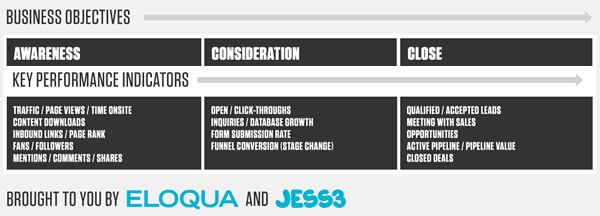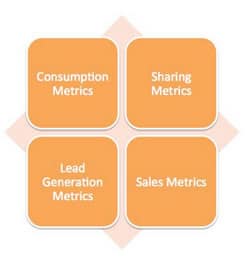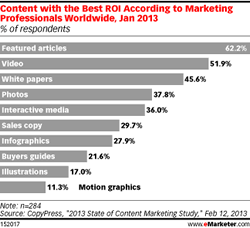One of the key challenges for marketers regarding content marketing is measuring the ROI (or metrics and KPIs, which is not the same).
The measurement challenge clearly showed in previous posts, comes back in virtually all surveys, and more importantly, all discussions we have regarding content marketing.
Although many businesses don’t really have a specific budget for content marketing, the sums spent on content marketing are often significant. So it seems logical we measure the impact and return using content marketing metrics and KPIs. Otherwise it’s hard to make the case…
Calculating the ROI of content marketing is done in a very similar way as calculating overall marketing ROI. In order to measure returns, depth of engagement and ROI, you need several content marketing metrics and KPIs. And marketing ROI is and remains a financial parameter…
Different content marketing metrics leading to an overall picture
As is shown in the famous Content Grid v2 by Eloqua and Jess3, the different content marketing metrics differ according to the stages and business goals.

Belgian content marketing company Mediaforta published a series of blog posts in Dutch about measuring the return of – digital – content marketing that was interesting. The metrics were grouped into 5 categories and we’ll tackle them in the rest of this article.
In order to know the return of your content marketing strategy efforts, you can focus on several KPIs and metrics, depending on your goals. Some – intermediary – KPIs and metrics will tell you if your content is engaging enough while others look at the real ROI. It’s essential to stay as close to your goals as possible though.
Essentially, Mediaforta says, we can group several content marketing metrics and KPIs as follows:
- Content consumption metrics.
- Content sharing metrics.
- Lead generation metrics.
- Sales metrics.
- Content marketing ROI.
Let’s take a look at those 5 groups. Note that real marketing ROI is not always how people define it. Here are five essential principles to improve digital marketing ROI, in order to speak the same language.
Content marketing metrics regarding content consumption

As you know you’re a bit of a publisher as a content marketer. And a publisher wants to know if his content is read, viewed, etc.
If it’s not read or ‘consumed’, you can’t achieve the end goals. Why are you writing or creating other forms of content anyway? Is what you doing engaging enough for your target audiences?
Some basic content consumption metrics:
- Page views: these are typically measured with web analytics platforms such as Google Analytics, Omniture, Webtrends, etc. and in some case by the proprietary analytics tools of specific (social) channels.
- Video views: most video hosting platforms can tell you how much viewers your video has reached. The better ones will make a distinction between viewers who started viewing your videos, but also the number of viewers who watched your videos until the end. If many people start watching your video but don’t view it completely, then maybe the video is not dynamic enough or simply too long.
- Document views: this is typically used for online presentations or eBooks and white papers that are shared with platforms such as SlideShare, Scribd or Prezi for example. How many viewers watched your presentation/eBook (and how many embeds are there?).
- Downloads: How many website visitors have downloaded your white paper, eBook? Most analytics programs will give you the tools to measure this and if you use form tools or marketing automation software, to name just two, you obviously get more insights.
Of course, there are more than these four content consumption metrics and KPIs. Examples include ‘pages/visit’ or ‘returning visitors’. But the four mentioned are among the most qualitative ones to measure pure consumption.
Content sharing metrics
When you have relevant and engaging content, people will share it.
This way the reach of the content is extended organically. It’s part of what we could call the ‘new link building’ with a personal and additional social dimension.
Some content marketing metrics regarding content sharing you can measure:
- Likes, shares, tweets, retweets: these are the classic social sharing metrics as they are used in social media. But let’s be clear, just like the content consumption metrics they are you’re your end goals. Social shares, the number of Facebook fans or your Twitter following doesn’t bring you revenue. It is just an indication that your content is relevant and share-worthy for your audiences and their audiences. Don’t forget that on top of these social sharing tools (SWYN or Share With Your Network), you can also track shares on other media and channels such as email (Forward to a Friend).
- Inbound links: how many other sites are linking to your content? This is also an indicator of how your content gets spread and shared. It’s important for your link building strategy but also a token of relevance, especially if the links come from sources that are relevant for your goals and target audiences. In this regard, you can also take into account embeds, pins for visual content, how often the content gets curated and much more.
Beyond content marketing metrics: lead generation metrics and KPIs

In the end, content marketing is about attracting, engaging, identifying, nurturing and converting leads (and servicing them once they are customers).
So, lead generation metrics are certainly important and even more so in B2B. How many leads did you get using content marketing tactics? How many have been turned into opportunities, etc.
Some lead generation metrics and indicators you can easily measure:
- Filled out contact forms: On top of using contact form tools or marketing automation software, you can also set up form metrics in your Google Analytics (or other web analytics) account. And depending on your backend, data can be collected into your CRM software.
- Subscriptions and registrations: this approach is similar to the contact forms. Track your newsletter subscribers, the people who signed up for a demo, etc. Identify the real leads among these suspects/ prospects.
- RSS subscribers: although this is more an indication of people liking your content, you can use RSS feeds to identify prospects, especially if you track them with email options using tools like Feedburner, that provide you more stats as well.
- Blog comments and social: it’s important to follow up on these, as with blog comments you have an opportunity to start a conversation. This is good for community purposes and interaction but – when well done and targeted – also to identify potential leads. In the end, this also goes for social media interactions.
The impact on sales
Depending on your organization, the integration of marketing and customer platforms and the way you have closed the gap between marketing and sales this can be easy or difficult. If you sell online, it’s obviously easier than in the case of other sales channels.
When you sell online, using your multi-channel reports in Google Analytics, for instance, will give you a clear goal on which tactics worked best for conversions and actual sales.
In the case of offline sales and more complex buying journeys, you need to have more tools and processes to be able to attribute the buy (or conversion). If you use content marketing as a way to improve branding (often in B2C if there’s no online sales) you need to gauge the impact of your content marketing efforts on branding and the impact of branding on sales.
Calculating the ROI of content marketing
The C-suite is really interested in the ROI of your marketing investments, including content marketing. The C-level doesn’t care about the number of blog readers, shares, page views, subscriptions or even suspects.
They care about revenue, profit and hot leads. Marketing ROI is increasingly used and required by management so it’s crucial to have a good view on the return of your content marketing investments (and all other marketing investments). You need to prove it’s worth the money.
Although calculating marketing ROI can be a really intensive process, you can work on some micro-levels, for instance blogging or social media ROI.
Step 1: calculate your investment cost
Here you really need to take into account all costs, in-house and outsourced. Include elements such as the hosting of your blog, content writing, needed resources, time spent on workflow, creation of infographics, production of videos, etc.
Of course in-house should be calculated too. When someone is writing a blog post, he or she is working 100% for your content marketing plan and not for something else. So timesheets can definitely be useful. Also include the cost of content marketing software, integrations, strategy, etc.
Step 2: calculate the return
In practice, many businesses work with averages. Although marketing ROI is used for planning mainly, you can also use it to track.
Suppose you have 7 new clients per month thanks to the leads generated using a blog and that a customer spends an average of 3,500 USD (7 x 3,500 = 24,500) with an average profit margin of 20% during his customer lifetime. The monthly return of the blog is then 4,900 USD (20% of 24,500).
The return of 4,900 USD minus the investment in the blog (for instance 4,000 USD) is the profit, in this example a profit of 900 dollar per month. The ROI of the blog is then 22,5%
Doing this exercise looks pretty straightforward in the case of a blog and when you’re able to isolate all elements. However, calculating the ROI of a full content marketing program is something else and requires more so it’s not something you do just like that. Most businesses have a gradual approach and that’s normal. But you need to measure and track to make the case for your content marketing plans and get buy-in for your program. Measure the right things and try to link the right content marketing metrics and KPIs for your individual business goals.
Oh, and don’t worry too much about industry benchmarks. Your organization, your customers and their behavior, your go-to-market, your geography, your culture, etc. But most of all and certainly if it’s new: you need to start somewhere. You can’t measure everything in one move. It’s step-by-step and starts with your goals and those of your target audiences.
Hopefully these examples of content marketing metrics help you getting started.


